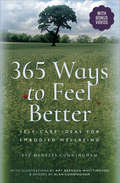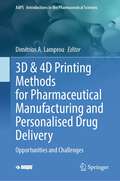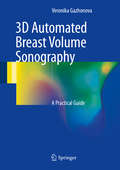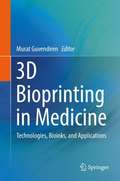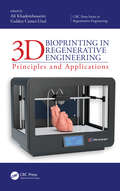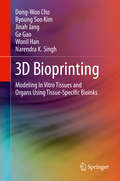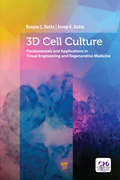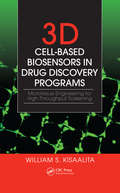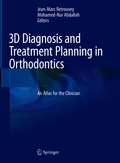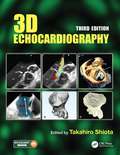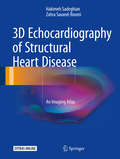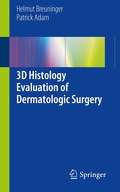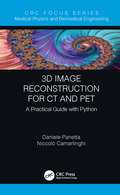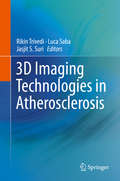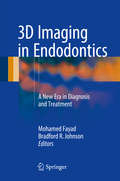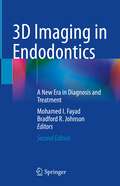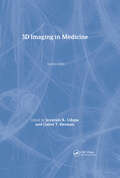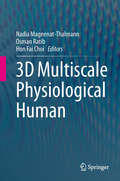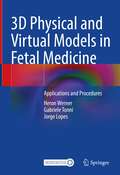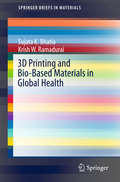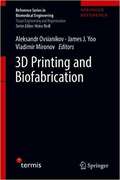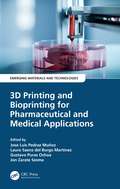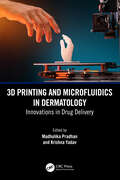- Table View
- List View
365 Ways to Feel Better: Self-Care Ideas for Embodied Wellbeing
by Eve Menezes Cunningham&“Pull[s] together 366 daily steps to help you live a happier, healthier, freer, and more fulfilled life. Let [Eve] be your inspiring guide for your year&” (Nick Williams, bestselling author of The Work We Were Born to Do). 365 Ways to Feel Better offers simple but effective tools for each day of the year. Eve Menezes Cunningham integrates her background in coaching, counseling, yoga, and other therapies to share practical tools for mind, body, heart, and soul. With an overall aim of supporting people in feeling better in all areas of their lives, Eve encourages the reader to learn to trust in their own capacity to heal and feel better, with a playful approach to their self-care. From goal setting to inner child work, chakras to beneficial yoga poses, breath practices to psychological tools, meditation techniques to aura cleansing, this book offers a taste of a comprehensive range of mind-body tools to help you boost your health and wellbeing. 365 Ways to Feel Better is for anyone who wants to boost their wellbeing in a holistic, side-effect-free way. Self-help fans will enjoy it, but also complementary therapists, energy workers, yoga instructors and yogis, counselors, coaches, and more. &“This book will transform your life. Radical self-care in easy baby steps, what&’s not to love?&” —Suzy Greaves, author of The Big Peace: Find Yourself Without Going Anywhere &“A fabulous book. So very well thought out, planned and executed and with a wonderful accessible yet respectful style.&” —Debra Jinks, coauthor of Personal Consultancy: A Model for Integrating Counselling and Coaching
37 Seconds: Dying Revealed Heaven's Help
by Stephanie Arnold Sari Padorr“Riveting . . . inspiring. . . . the story of what happened to this woman when she died for 37 seconds will make you rethink how we all should live.” —Maureen Maher, CBS News correspondent, 48 HoursWhen she was pregnant with her second child, Stephanie Arnold had a sudden and overwhelming premonition that she would die during the delivery. Though she tried to tell the medical team and her family what was going to happen, neither the doctors nor her loved ones gave her warnings credence. Finding no physical indications that anything was wrong, they attributed her foreboding to hormones and anxiety.One member of the medical team did take her concerns seriously enough, and made the fateful decision to order extra units of blood “just in case.” Then, during the delivery, Stephanie suffered a rare Amniotic Fluid Embolism. She went into cardiac arrest and flat-lined for 37 seconds. She died. Using the supplementary blood, the medical team revived her, and she remained unconscious for more than six days.After months of recovery, Stephanie began to remember details of her experience, details she knew because she had witnessed the entire dramatic event, including her death, from outside her body—beside other spirits that were with her. In this remarkable true story, Stephanie recounts her harrowing journey and shares her surprising spiritual discoveries: we are not alone and have more loving help than we can imagine surrounding us.“Stephanie Arnold’s journalistic instincts made this remarkable happening a compelling reading experience.” —Dennis Swanson, President of Station Operations at Fox Television“Arnold’s amazing, enthralling, and revealing story . . . could redefine the way clergy, physicians, and scientists think about dying.” —Dr. Rachael Ross, co-host of The Doctors
3D & 4D Printing Methods for Pharmaceutical Manufacturing and Personalised Drug Delivery: Opportunities and Challenges (AAPS Introductions in the Pharmaceutical Sciences #11)
by Dimitrios A. LamprouNew materials and manufacturing techniques are emerging with potential to address the challenges associated with the manufacture of pharmaceutical systems that will teach new tricks to old drugs. 3D printing (3DP) is a technique that can used for the manufacturing of dosage forms, and especially targeting paediatric and geriatric formulations, as permits the fabrication of high degrees of complexity with great reproducibility, in a fast and cost-effective fashion, and offers a new paradigm for the direct manufacture of personalised dosage forms. The book is covering the basics behind each additive manufacturing (AM) method, current applications in pharmaceutics for each 3DP method, and case studies (examples) from a teaching perspective, targeting undergraduate (UG) and postgraduate (PG) students. A unique to this book is the integration of studies based upon the use of different AM technologies, which designed to reinforce importance printing parameters and material considerations. The book includes case studies or multiple-choice questions (MCQs), which allow application of the content in a flipped-classroom.
3D Automated Breast Volume Sonography: A Practical Guide
by Veronika GazhonovaThisbook introduces an exciting new method for breast ultrasound diagnostics - automatedwhole-breast volume scanning (3D ABVS). Scanning technique is described indetail, with guidance on scanning positions and protocols. Imaging findings arethen illustrated and discussed for normal breast variants, the different formsof breast cancer, fibroadenomas, cystic disease, benign and malignant malebreast disorders, mastitis, breast implants, and postoperative breast scars. Inorder to aid appreciation of the benefits of 3D ABVS, comparisons with findingson X-ray mammography and conventional 2D hand-held US are presented. Readerswill be especially impressed by the convincing demonstration of the advantagesof the new method for diagnosis of breast cancer in women with dense glandulartissue. In enabling readers to learn how to perform and interpret 3D ABVS, thisbook will be of great value for all who are embarking on its use. It will alsoserve as a welcome reference for radiologists, oncologists, and ultrasonographerswho already have some familiarity with the technique.
3D Bioprinting in Medicine: Technologies, Bioinks, and Applications
by Murat GuvendirenThis book provides current and emerging developments in bioprinting with respect to bioprinting technologies, bioinks, applications, and regulatory pathways. Topics covered include 3D bioprinting technologies, materials such as bioinks and bioink design, applications of bioprinting complex tissues, tissue and disease models, vasculature, and musculoskeletal tissue. The final chapter is devoted to clinical applications of bioprinting, including the safety, ethical, and regulatory aspects. This book serves as a go-to reference on bioprinting and is ideal for students, researchers and professionals, including those in academia, government, the medical industry, and healthcare.
3D Bioprinting in Regenerative Engineering: Principles and Applications (CRC Press Series In Regenerative Engineering)
by Ali Khademhosseini Gulden Camci-UnalRegenerative engineering is the convergence of developmental biology, stem cell science and engineering, materials science, and clinical translation to provide tissue patches or constructs for diseased or damaged organs. Various methods have been introduced to create tissue constructs with clinically relevant dimensions. Among such methods, 3D bioprinting provides the versatility, speed and control over location and dimensions of the deposited structures. Three-dimensional bioprinting has leveraged the momentum in printing and tissue engineering technologies and has emerged as a versatile method of fabricating tissue blocks and patches. The flexibility of the system lies in the fact that numerous biomaterials encapsulated with living cells can be printed. This book contains an extensive collection of papers by world-renowned experts in 3D bioprinting. In addition to providing entry-level knowledge about bioprinting, the authors delve into the latest advances in this technology. Furthermore, details are included about the different technologies used in bioprinting. In addition to the equipment for bioprinting, the book also describes the different biomaterials and cells used in these approaches. This text: Presents the principles and applications of bioprinting Discusses bioinks for 3D printing Explores applications of extrusion bioprinting, including past, present, and future challenges Includes discussion on 4D Bioprinting in terms of mechanisms and applications
3D Bioprinting: Modeling In Vitro Tissues and Organs Using Tissue-Specific Bioinks
by Ge Gao Dong-Woo Cho Byoung Soo Kim Jinah Jang Wonil Han Narendra K. SinghThis text advances fundamental knowledge in modeling in vitro tissues/organs as an alternative to 2D cell culture and animal testing. Prior to engineering in vitro tissues/organs,the descriptions of prerequisites (from pre-processing to post-processing) in modeling in vitro tissues/organs are discussed. The most prevalent technologies that have been widely used for establishing the in vitro tissue/organ models are also described, including transwell, cell spheroids/sheets, organoids, and microfluidic-based chips. In particular, the authors focus on 3D bioprinting in vitro tissue/organ models using tissue-specific bioinks. Several representative bioprinting methods and conventional bioinks are introduced. As a bioink source, decellularized extracellular matrix (dECM) are importantly covered, including decellularization methods, evaluation methods for demonstrating successful decellularization, and material safety. Taken together, the authors delineate various application examples of 3D bioprinted in vitro tissue/organ models especially using dECM bioinks.
3D Cell Culture: Fundamentals and Applications in Tissue Engineering and Regenerative Medicine
by Ranjna C. Dutta Aroop K. Dutta3D cell culture is yet to be adopted and exploited to its full potential. It promises to upgrade and bring our understanding about human physiology to the highest level with the scope of applying the knowledge for better diagnosis as well as therapeutics. The focus of this book is on the direct impact of novel technologies and their evolution into viable products for the benefit of human race. It also describes the fundamentals of cell microenvironment to bring forth the relevance of 3D cell culture in tissue engineering and regenerative medicine. It discusses the extracellular matrix/microenvironment (ECM) and emphasizes its significance for growing cells in 3D to accomplish physiologically viable cell mass/tissue ex vivo. The book bridges the knowledge gaps between medical need and the technological applications through illustrations. It discusses the available models for 3D cell culture as well as the techniques to create substrates and scaffolds for achieving desired 3D microenvironment.
3D Cell-Based Biosensors in Drug Discovery Programs: Microtissue Engineering for High Throughput Screening
by William S. KisaalitaAdvances in genomics and combinatorial chemistry during the past two decades inspired innovative technologies and changes in the discovery and pre-clinical development paradigm with the goal of accelerating the process of bringing therapeutic drugs to market. Written by William Kisaalita, one of the foremost experts in this field, 3D Cell-Based Bio
3D Diagnosis and Treatment Planning in Orthodontics: An Atlas for the Clinician
by Jean-Marc Retrouvey Mohamed-Nur AbdallahThis richly illustrated book is a wide-ranging guide to modern diagnostics and treatment planning in orthodontics, which are mandatory prior to the initiation of any type of comprehensive treatment. The importance of three-dimensional (3D) imaging techniques has been increasingly recognized owing to the shortcomings of conventional two-dimensional imaging in some patients, such as those requiring complex adult treatment and those with temporomandibular joint dysfunctions or sleep disturbances. In the first part of this book, readers will find clear description and illustration of the diagnostic role of the latest 3D imaging techniques, including cone beam computed tomography, intra-oral scanning, and magnetic resonance imaging. The second part explains in detail the application of 3D techniques in treatment planning for orthodontic and orthognathic surgery. Guidance is also provided on the use of image fusion software for the purposes of accurate diagnosis and precise design of the most appropriate biomechanical approach in patients with malocclusions.
3D Echocardiography
by Takahiro ShiotaSince the publication of the second edition of this volume, 3D echocardiography has penetrated the clinical arena and become an indispensable tool for patient care. The previous edition, which was highly commended at the British Medical Book Awards, has been updated with recent publications and improved images. This third edition has added important new topics such as 3D Printing, Surgical and Transcatheter Management, Artificial Valves, and Infective Endocarditis. The book begins by describing the principles of 3D echocardiography, then proceeds to discuss its application to the imaging of • Left and Right Ventricle, Stress Echocardiography • Left Atrium, Hypertrophic Cardiomyopathy • Mitral Regurgitation with Surgical and Nonsurgical Procedures • Mitral Stenosis and Percutaneous Mitral Valvuloplasty • Aortic Stenosis with TAVI / TAVR • Aortic and Tricuspid Regurgitation • Adult Congenital Heart Disease, Aorta • Speckle Tracking, Cardiac Masses, Atrial Fibrillation KEY FEATURES In-depth clinical experiences of the use of 3D/2D echo by world experts Latest findings to demonstrate clinical values of 3D over 2D echo One-click view of 263 innovative videos and 352 high-resolution 3D/2D color images in a supplemental eBook.
3D Echocardiography of Structural Heart Disease: An Imaging Atlas
by Hakimeh Sadeghian Zahra Savand-RoomiThis atlas presents outstanding three-dimensional (3D) echocardiographic images of structural heart diseases, including congenital and valvular diseases and cardiac masses and tumors. The aim is to enable the reader to derive maximum diagnostic and treatment benefit from the modality through optimal image acquisition and interpretation. To this end a wide range of instructive individual cases are depicted, with sequential arrangement of all images and views of diagnostic value, including 3D zoom, full-volume, and live 3D images. For each case, a key lesson is highlighted and attention is drawn to aspects of relevance to diagnosis and treatment. In addition, readers will have online access to echocardiographic video clips for each patient. The closing part of the book examines the role of 3D echocardiography in structural heart disease interventions. The superb quality of the illustrations and the range of cases considered ensure that this atlas will be an excellent visual learning tool and an ideal aid for cardiology residents and fellows in day-to-day clinical practice.
3D Histology Evaluation of Dermatologic Surgery
by Patrick Adam Helmut BreuningerThere hasn't been a book concerning "Microscopically Controlled Surgery" published and it is vital to publish a book that details all the different terms and methodology used in microscopically controlled surgery. The goal is to create a practical, concise and simple explanation of 3D-histology with workflows and detailed illustrative material for dermatologists. It is therefore designed to be a goal-oriented manual rather than an exhaustive reference work. It will provide the essential information for all working with patients undergoing this group of treatments.
3D Image Reconstruction for CT and PET: A Practical Guide with Python (Focus Series in Medical Physics and Biomedical Engineering)
by Daniele Panetta Niccolo CamarlinghiThis is a practical guide to tomographic image reconstruction with projection data, with strong focus on Computed Tomography (CT) and Positron Emission Tomography (PET). Classic methods such as FBP, ART, SIRT, MLEM and OSEM are presented with modern and compact notation, with the main goal of guiding the reader from the comprehension of the mathematical background through a fast-route to real practice and computer implementation of the algorithms. Accompanied by example data sets, real ready-to-run Python toolsets and scripts and an overview the latest research in the field, this guide will be invaluable for graduate students and early-career researchers and scientists in medical physics and biomedical engineering who are beginners in the field of image reconstruction. A top-down guide from theory to practical implementation of PET and CT reconstruction methods, without sacrificing the rigor of mathematical background Accompanied by Python source code snippets, suggested exercises, and supplementary ready-to-run examples for readers to download from the CRC Press website Ideal for those willing to move their first steps on the real practice of image reconstruction, with modern scientific programming language and toolsets Daniele Panetta is a researcher at the Institute of Clinical Physiology of the Italian National Research Council (CNR-IFC) in Pisa. He earned his MSc degree in Physics in 2004 and specialisation diploma in Health Physics in 2008, both at the University of Pisa. From 2005 to 2007, he worked at the Department of Physics "E. Fermi" of the University of Pisa in the field of tomographic image reconstruction for small animal imaging micro-CT instrumentation. His current research at CNR-IFC has as its goal the identification of novel PET/CT imaging biomarkers for cardiovascular and metabolic diseases. In the field micro-CT imaging, his interests cover applications of three-dimensional morphometry of biosamples and scaffolds for regenerative medicine. He acts as reviewer for scientific journals in the field of Medical Imaging: Physics in Medicine and Biology, Medical Physics, Physica Medica, and others. Since 2012, he is adjunct professor in Medical Physics at the University of Pisa. Niccolò Camarlinghi is a researcher at the University of Pisa. He obtained his MSc in Physics in 2007 and his PhD in Applied Physics in 2012. He has been working in the field of Medical Physics since 2008 and his main research fields are medical image analysis and image reconstruction. He is involved in the development of clinical, pre-clinical PET and hadron therapy monitoring scanners. At the time of writing this book he was a lecturer at University of Pisa, teaching courses of life-sciences and medical physics laboratory. He regularly acts as a referee for the following journals: Medical Physics, Physics in Medicine and Biology, Transactions on Medical Imaging, Computers in Biology and Medicine, Physica Medica, EURASIP Journal on Image and Video Processing, Journal of Biomedical and Health Informatics.
3D Imaging Technologies in Atherosclerosis
by Jasjit S. Suri Rikin Trivedi Luca SabaAtherosclerosis represents the leading cause of mortality and morbidity in the world. Two of the most common, severe, diseases that may occur, acute myocardial infarction and stroke, have their pathogenesis in the atherosclerosis that may affect the coronary arteries as well as the carotid/intra-cranial vessels. Therefore, in the past there was an extensive research in identifying pre-clinical atherosclerotic diseases in order to plan the correct therapeutical approach before the pathological events occur. In the last 20 years imaging techniques and in particular Computed Tomography and Magnetic Resonance had a tremendous improvement in their potential. In the field of the Computed Tomography the introduction of the multi-detector-row technology and more recently the use of dual energy and multi-spectral imaging provides an exquisite level of anatomic detail. The MR thanks to the use of strength magnetic field and extremely advanced sequences can image human vessels very quickly while offering an outstanding contrast resolution.
3D Imaging in Endodontics: A New Era in Diagnosis and Treatment
by Mohamed Fayad Bradford R. JohnsonThis book is designed to provide the reader with a full understanding of the role of cone beam computed tomography (CBCT) in helping to solve many of the most challenging problems in endodontics. It will shorten the learning curve in application of this exciting imaging technique in a variety of contexts: difficult diagnostic cases, treatment planning, evaluation of internal tooth anatomy prior to root canal therapy, nonsurgical and surgical treatments, early detection and treatment of resorptive defects, and outcomes assessment. The ability to obtain an accurate 3D representation of a tooth and the surrounding structures by means of noninvasive CBCT imaging is changing the approach to clinical decision making in endodontics. Clinicians long accustomed to working in very small, three-dimensional spaces are no longer constrained by the limitations of two-dimensional imaging. The challenges of mastering the new technology can, however, be daunting. The detailed guidance contained in this book will help endodontists to take full advantage of the important benefits offered by CBCT.
3D Imaging in Endodontics: A New Era in Diagnosis and Treatment
by Bradford R. Johnson Mohamed I. FayadThis book, now in an extensively revised second edition, is designed to provide the reader with a full understanding of the role of cone beam computed tomography (CBCT) in helping to solve many of the most challenging problems in endodontics. It will shorten the learning curve in application of this exciting imaging technology in a variety of contexts: difficult diagnostic cases, treatment planning, evaluation of internal tooth anatomy prior to root canal therapy, nonsurgical and surgical treatments, early detection and treatment of resorptive defects, and outcomes assessment. The ability to obtain an accurate 3D representation of a tooth and the surrounding structures by means of noninvasive CBCT imaging is changing the approach to clinical decision making in endodontics. Clinicians long accustomed to working in very small, three-dimensional spaces are no longer constrained by the limitations of two-dimensional imaging. The challenges of mastering the new technology can, however, be daunting. The detailed guidance contained in this book will help endodontists to take full advantage of the important benefits offered by CBCT.
3D Imaging in Medicine, Second Edition
by Gabor T. Herman Jayaram K. UdupaThis book provides a quick and systematic presentation of the principles of biomedical visualization and three-dimensional (3D) imaging. Topics discussed include basic principles and algorithms, surgical planning, neurosurgery, orthopedics, prosthesis design, brain imaging, cardio-pulmonary structure analysis and the assessment of clinical efficacy. Students, scientists, researchers, and radiologists will find 3D Imaging in Medicine a valuable source of information for a variety of actual and potential clinical applications for 3-D imaging.
3D Multiscale Physiological Human
by Nadia Magnenat-Thalmann Osman Ratib Hon Fai Choi3D Multiscale Physiological Human aims to promote scientific exchange by bringing together overviews and examples of recent scientific and technological advancements across a wide range of research disciplines. As a result, the variety in methodologies and knowledge paradigms are contrasted, revealing potential gaps and opportunities for integration. Chapters have been contributed by selected authors in the relevant domains of tissue engineering, medical image acquisition and processing, visualization, modeling, computer aided diagnosis and knowledge management. The multi-scale and multi-disciplinary research aspects of articulations in humans are highlighted, with a particular emphasis on medical diagnosis and treatment of musculoskeletal diseases and related disorders. The need for multi-scale modalities and multi-disciplinary research is an emerging paradigm in the search for a better biological and medical understanding of the human musculoskeletal system. This is particularly motivated by the increasing socio-economic burden of disability and musculoskeletal diseases, especially in the increasing population of elderly people. Human movement is generated through a complex web of interactions between embedded physiological systems on different spatiotemporal scales, ranging from the molecular to the organ level. Much research is dedicated to the understanding of each of these systems, using methods and modalities tailored for each scale. Nevertheless, combining knowledge from different perspectives opens new venues of scientific thinking and stimulates innovation. Integration of this mosaic of multifaceted data across multiple scales and modalities requires further exploration of methods in simulations and visualization to obtain a comprehensive synthesis. However, this integrative approach cannot be achieved without a broad appreciation for the multiple research disciplines involved.
3D Physical and Virtual Models in Fetal Medicine: Applications and Procedures
by Gabriele Tonni Heron Werner Jorge LopesTechnological innovations accompanying advances in medicine have given rise to the possibility of obtaining better-defined fetal images that assist in medical diagnosis and contribute toward genetic counseling offered to parents during the prenatal care. 3D printing is an emerging technique with a variety of medical applications such as surgical planning, biomedical research and medical education.Clinical Relevance: 3D physical and virtual models from ultrasound and magnetic resonance imaging have been used for educational, multidisciplinary discussion and plan therapeutic approaches. The authors describe techniques that can be applied at different stages of pregnancy and constitute an innovative contribution to research on fetal abnormalities. We will show that physical models in fetal medicine can help in the tactile and interactive study of complex abnormalities in multiple disciplines. They may also be useful for prospective parents because a 3D physical model with the characteristics of the fetus should allow a more direct emotional connection to their unborn child.
3D Printing and Bio-Based Materials in Global Health: An Interventional Approach to the Global Burden of Surgical Disease in Low-and Middle-Income Countries (SpringerBriefs in Materials #First Edition)
by Sujata K. Bhatia Krish W. RamaduraiThis book examines the potential to deploy low-cost, three-dimensional printers known as RepRaps in developing countries to fabricate surgical instruments and medical supplies to combat the “global surgical burden of disease.” <P><P>Approximately two billion people in developing countries around the world lack access to essential surgical services, resulting in the avoidable deaths of millions of individuals each year. A fundamental barrier that inhibits access to surgical care in these locations is the lack of basic surgical instruments and supplies in healthcare facilities. RepRap printers are highly versatile 3D printers assembled from basic, domestically sourced materials that can fabricate low-cost surgical instruments on-site, ultimately enhancing the interventional capacity of healthcare facilities to treat patients. <P><P> Rather than focusing on one specific field of interest, this book takes an integrative approach that incorporates topics and methods from multiple disciplines ranging from global health and development economics to materials science and applied engineering. <P> These topics include the feasibility of using bio-based plastics to fabricate surgical instruments via 3D printing sustainably, the application of "frugal innovation and engineering” in resource-poor settings, and analyses related to the social returns on investment, barriers to entry, and current and future medical device supply-chain paradigms. In taking a multi-disciplinary approach, the reader can gain a holistic understanding of the multiple facets related to implementing medical device innovations in developing countries.
3D Printing and Biofabrication (Tissue Engineering and Regeneration)
by Aleksandr Ovsianikov James Yoo Vladimir MironovProvides an in-depth introduction to 3D printing and biofabrication.<P><P> Covers inkjet, extrusion and laser-based processing of cell-containing materials.<P> Includes mathematical models used in tissue engineering.<P>This volume provides an in-depth introduction to 3D printing and biofabrication and covers the recent advances in additive manufacturing for tissue engineering. The book is divided into two parts, the first part on 3D printing discusses conventional approaches in additive manufacturing aimed at fabrication of structures, which are seeded with cells in a subsequent step. The second part on biofabrication presents processes which integrate living cells into the fabrication process.
3D Printing and Bioprinting for Pharmaceutical and Medical Applications (Emerging Materials and Technologies)
by Jose Luis Pedraz Muñoz Laura Saenz del Burgo Martínez Gustavo Puras Ochoa Jon Zarate SesmaThe increasing availability and decreasing costs of 3D printing and bioprinting technologies are expanding opportunities to meet medical needs. 3D Printing and Bioprinting for Pharmaceutical and Medical Applications discusses emerging approaches related to these game-changer technologies in such areas as drug development, medical devices, and bioreactors. Key Features: Offers an overview of applications, the market, and regulatory analysis Analyzes market research of 3D printing and bioprinting technologies Reviews 3D printing of novel pharmaceutical dosage forms for personalized therapies and for medical devices, as well as the benefits of 3D printing for training purposes Covers 3D bioprinting technology, including the design of polymers and decellularized matrices for bio-inks development, elaboration of 3D models for drug evaluation, and 3D bioprinting for musculoskeletal, cardiovascular, central nervous system, ocular, and skin applications Provides risk-benefit analysis of each application Highlights bioreactors, regulatory aspects, frontiers, and challenges This book serves as an ideal reference for students, researchers, and professionals in materials science, bioengineering, the medical industry, and healthcare.
3D Printing and Microfluidics in Dermatology: Innovations in Drug Delivery
by Madhulika Pradhan Krishna Yadav3D Printing and Microfluidics in Dermatology provides a thorough exploration and applications of three-dimensional (3D) printing and microfluidics within the field of dermatology. It investigates various methods utilized in these fields, such as 3D bioprinting, nano-transporters, microscopic fabrication, and device development.The book not only examines practical applications but also delves into the design principles crucial for implementing these techniques using specific materials tailored to their intended purposes. Additionally, it addresses ethical concerns and regulatory considerations pertinent to these evolving technologies.Key highlights include the following: A detailed insight into the utilization of 3D printing and microfluidic technologies for treating skin disorders. Exploration of design concepts necessary for effective implementation, considering the unique properties of materials involved. Coverage of diverse methodologies, ranging from 3D bioprinting to nano-transporters, microscopic fabrication, and device engineering. In-depth discussion on ethical considerations vital for the sustainable development of the industry. Investigation into advancements in material development, device design, fabrication techniques, and performance evaluation through preclinical and clinical studies. This book targets graduate students and researchers in fields such as 3D printing, dermatology, drug delivery, bioengineering, and pharmaceutical sciences.
3D Printing at Hospitals and Medical Centers: A Practical Guide for Medical Professionals
by Frank J. Rybicki Gerald T. Grant Jonathan M. MorrisThis new edition describes the fundamentals of three-dimensional (3D) printing as applied to medicine and extends the scope of the first edition of 3D Printing in Medicine to include modern 3D printing within Health Care Facilities, also called at the medical “Point-Of-Care” (POC). This edition addresses the practical considerations for, and scope of hospital 3D printing facilities, image segmentation and post-processing for Computer Aided Design (CAD) and 3D printing. The book provides details regarding technologies and materials for medical applications of 3D printing, as well as practical tips of value for physicians, engineers, and technologists. Individual, comprehensive chapters span all major organ systems that are 3D printed, including cardiovascular, musculoskeletal, craniomaxillofacial, spinal, neurological, thoracic, and abdominal. The fabrication of maxillofacial prosthetics, the planning of head and neck reconstructions, and 3D printed medical devices used in cranial reconstruction are also addressed. The second edition also includes guidelines and regulatory considerations, costs and reimbursement for medical 3D printing, quality assurance, and additional applications of CAD such as virtual reality. There is a new Forward written by Ron Kikinis, PhD and a new Afterword written by Michael W. Vannier, MD. This book offers radiologists, surgeons, and other physicians a rich source of information on the practicalities and expanding medical applications of 3D printing. It will also serve engineers, physicist, technologists, and hospital administrators who undertake 3D printing. The second edition is designed as a textbook and is expected to serve in this capacity to fill educational needs in both the medical and engineering sectors.
